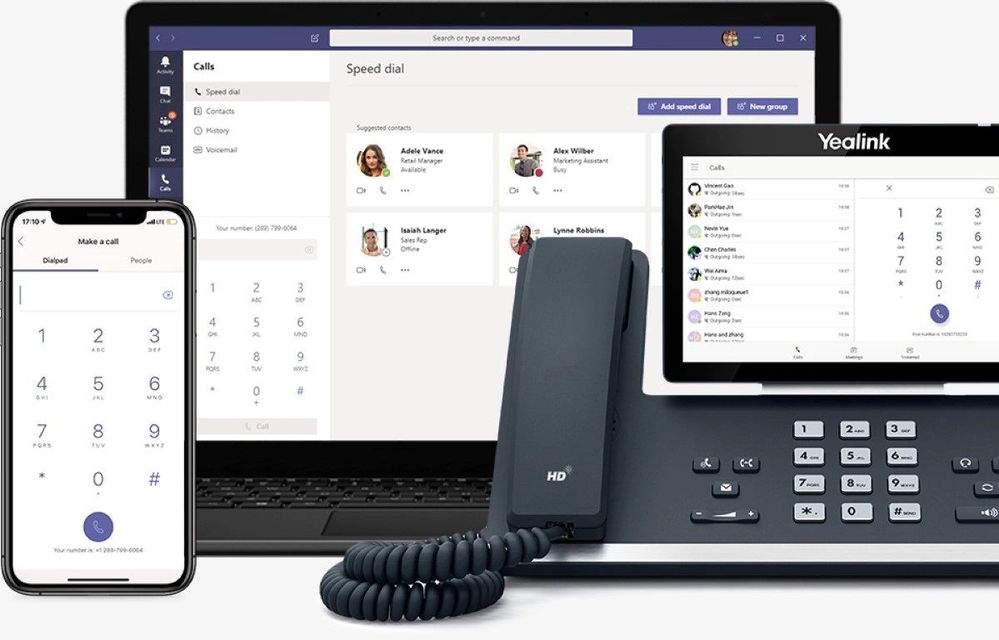The COVID-19 pandemic certainly created an impact our day-to-day job, forcing many businesses to re-write their work from home policies and adapt quickly. Through this adoption a question asked often, “how can I make my business calls when my phone is on my office desk?” I don’t want to make calls using my personal cellphone, otherwise, it would end up exposing my private phone number. So how should we go about this? Microsoft Teams.
{% video_player “embed_player” overrideable=False, type=’scriptV4′, hide_playlist=True, viral_sharing=False, embed_button=False, autoplay=False, hidden_controls=False, loop=False, muted=False, full_width=False, width=’640′, height=’360′, player_id=’28810108110′, style=’margin: 0px auto 10px;’ %}
Impacted heavily was the healthcare field. Many healthcare providers were super busy treating patients and not looking into their desk phone missed calls or voicemails, which could result in missing vital information that is required to treat patients.
One thing learned during this pandemic is, an organization needs to prepare their team to be able to work from wherever they are and needs to be effective. They can not rely on bolt-on desk devices and a plethora of applications to do their day to day job, specially for communications (Persistent Chat/Meetings and Telephony).
Most of the telephone servers or appliance called “PBX” is deployed in the data center closet, running for several years. It has hardwired desk phones for end-users to make and receive calls. Everything was working as intended prior to the pandemic.
However, to support social distancing, businesses are now required to adopt new methods to work from home and the healthcare mobile workforce to be more effective for communications and collaboration.
Scrambling for solutions, many organizations are not aware of what Microsoft Teams is capable of. We have seen that some organizations are already using Teams for Instant Messaging/Collaboration and Peer to Peer calling, however, that is the extent of their usage.
Let’s look a little deeper into Microsoft Teams. It is a cloud-born Microsoft product that has been adopted around the world, with 2.7 billion minutes a day, and 44M daily active users.
Unlike other siloed applications for telephony and meetings solutions, Microsoft Teams provides everything a user needs from chat, collaboration, group chat, secure messaging, telehealth, virtual rounding, meetings and voice/telephony, and much more.
A user does not need to open any other application nor requires any 3rd party software to manage security like DLP, MFA, etc. A user can download the Microsoft Teams app on any device and procure a consistent interface to consume. For example, Mac, Browser, iPhone, Android, and even Linux. If you are using Office365, you can use Teams.
If you are not using Teams today but have Office365 deployed in your organization, you can download and use it from teams.microsoft.com. Take a moment to discuss with your IT department to enable Teams for use. If you haven’t used Office 365 yet, you can sign up here.
Why Teams as a telephone?

- Call Answer/Hold/Park/Voicemail/Simultaneous ring and many features listed here
- Users can simply make and receive a call like they are in the office
- Can get telephone number directly from Microsoft in a matter of seconds and enable users for telephony (supported countries, look for calling plan section)
- They can keep the same number in Teams as office number (DID) and even mask their outgoing number (DID) to organization IVR (Interactive Voice Response) or main office number
- Users don’t need to switch applications to do chat/meetings or even voice/telephony, uses Teams for everything for the modern workplace
- Security, privacy and compliance built-in and much more
- Co-exist with legacy PBX or eliminate existing legacy PBX
- If required, can port existing office number (supported countries) or use existing Telephone voice trunks that are sitting inside existing data center closets using certified Session border controllers like Audiocodes, Ribbon and more
How can you enable this service?
Assuming you are currently using Microsoft Teams, there are a variety of ways you can enable this service to function. Bottom line is, you will need a “Phone system” license + “Calling Plan”. Phone system license enables PBX function for user and the Calling Plan allows to make and receive calls.
We highly recommend you discuss with your license reseller or Microsoft account representative to discuss licensing details and options. WheelHouse IT can take on the role of being your trusted Microsoft Gold Partner.
Once you have licenses in your Office 365 tenant, apply a license to a user, acquire/assign a phone number to the user, it’s really that simple.
Organizations should transform their business by simplifying communications infrastructure, reducing the cost that improves overall efficiency/productivity/mobility and security using Microsoft cloud service.
{{cta(‘3bce746d-3a67-47b6-b4ac-150b51e78c01′,’justifycenter’)}}
WheelHouse IT can set your organization up for success – You can learn more about Microsoft 365 Business Voice here.













